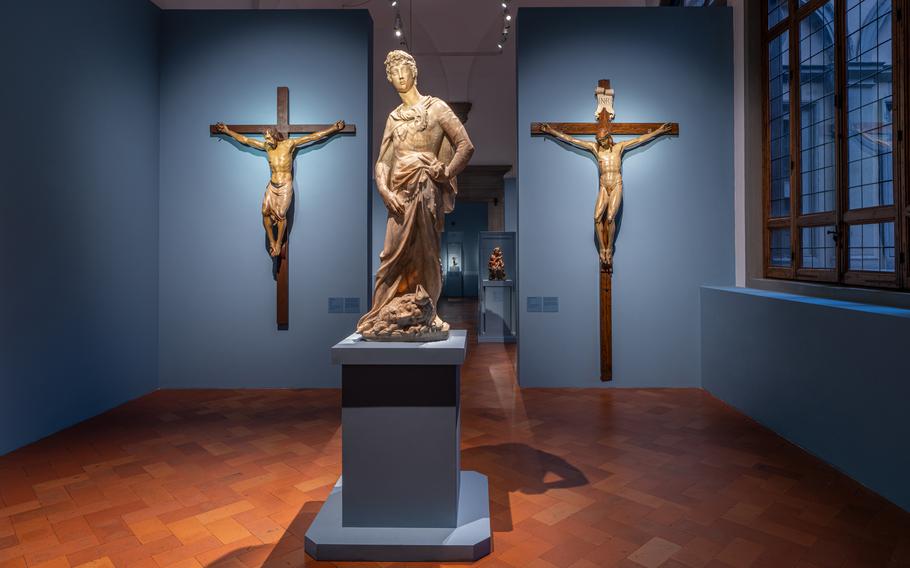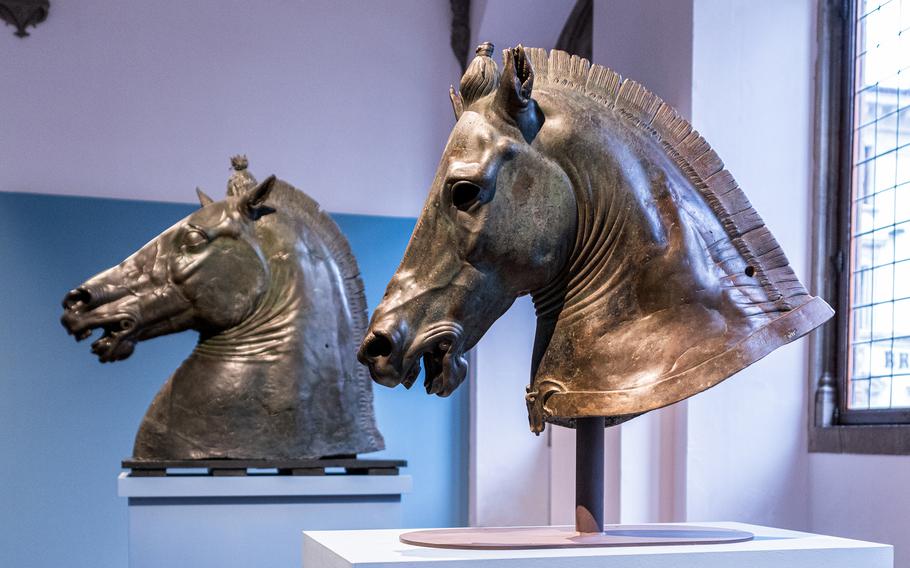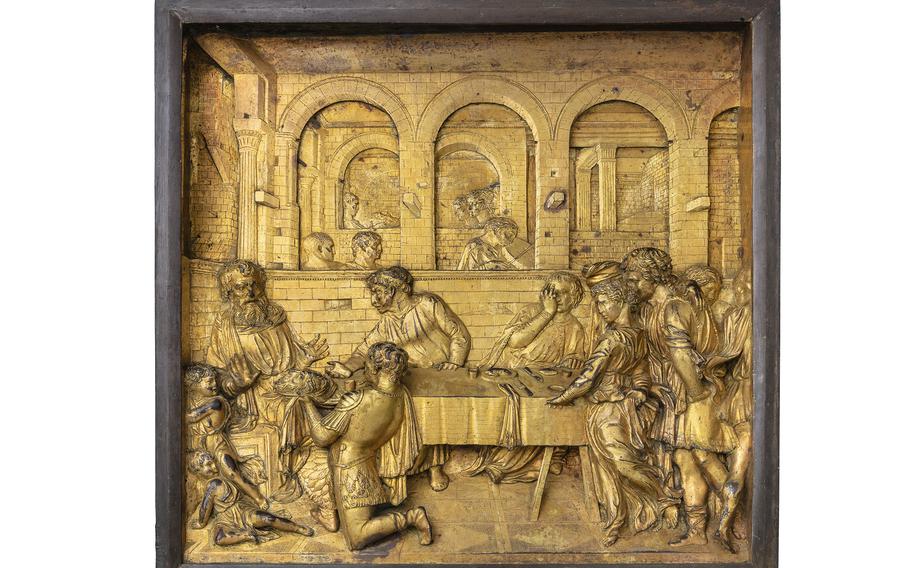
Donatello’s early statue of a clothed David in front of two crucifixes made from painted wood, the one on the left by Donatello, the one on the right by Filippo Brunelleschi. (Ela Bialkowska/OKNOstudio)
Every textbook introduction to Renaissance art emphasizes the central importance of two sculptures of David, the youth who killed Goliath and later became king of the Israelites. Both are in Florence, where, during the Renaissance, David was established as a symbol of the city. Both show David nude. One, by Donatello, seems to prophesy the other, by Michelangelo.
Michelangelo's David is the more famous of the two. Carved from marble, his 17-foot-tall figure is robust, muscular and unequivocally masculine.
Donatello's earlier, smaller David, in bronze, is adolescent, almost androgynous. His nudity is set off by his helmet, fancy boots and enormous sword. His casual, almost sashaying pose - as if he were vamping at the end of a catwalk - lends the sculpture a teasing eroticism. The impression is compounded by the feathered wing coming off the side of Goliath's helmet right up David's inner thigh.
Donatello (c. 1386-1466) is now the subject of a retrospective in Florence, the first since a 1985-1986 exhibition marking the 600th anniversary of his birth. It's refreshing to have him presented as the main attraction. The exhibition is spread across two venues, the Palazzo Strozzi and the nearby Bargello, bringing together 130 works from 50 collections. The title - not "Donatello and the Renaissance" but simply "Donatello, the Renaissance" - is a reminder that without Donatello, the Italian Renaissance is unimaginable.
The show demonstrates Donatello's profound influence on other artists. And in emphasizing genealogies - sometimes with whole walls dedicated to different artists addressing the same subject - it gets you thinking about what it means both to achieve precedence and to claim someone else's mantle.
During the Renaissance, Florentines were obsessed with questions of lineage, not only in art but also in religious and civic life. Positioning themselves as the rightful inheritors of republican Rome, they treated the Greek and Roman gods as natural precursors to the divine order laid out in the Bible. In this same spirit, art historians are forever casting Donatello in the role of John the Baptist to Michelangelo's Christ. Donatello is the Precursor - the opening act to Michelangelo's thundering apotheosis.
But it was Donatello who, more than any artist, led Italian art out of the Middle Ages. He replaced the stylizations of International Gothic with a new emphasis on real figures with frank, expressive faces and body postures that animate the space around them. His impact has been likened to that of an earthquake.
Some scholars have argued that Donatello's David alludes to the winged god Mercury's victory over the giant Argus. Regardless, the youth's foot resting on Goliath's head certainly symbolizes the victory of liberty and intelligence - qualities Florentines identified with their own city - over brute force and tyranny.
David, like John the Baptist, is often seen as a forerunner to the Messiah, so the Bible continues to resonate in Donatello's otherwise pagan-seeming interpretation. But Donatello's evocation of youth, restrained force, grace and hedonistic beauty all spoke to a new vision of the sovereign human figure occupying a central place in the world.
This, above all, was the Donatello earthquake. We're still feeling the aftershocks.

In front, the head of an ancient Greek equestrian statue once in Cosimo de Medici’s classical collection, under the care of Donatello. Behind, on the left, Donatello’s bronze head of a horse. (Ela Bialkowska/OKNOstudio/Sutton Comms)
The show will travel to Berlin and London. But Florence feels like the place to see it, if possible. During Donatello's life, the city was one vast workshop, as it vied for political and cultural supremacy with Milan. In a frenzy of competitive energy, the city's guilds lavished attention on its unfinished cathedral, its neighboring baptistery and the former granary-turned-church of Orsanmichele. Donatello began work on the cathedral as a 20-year-old. Over the next half-century, despite long stints away from Florence, he helped to adorn all three buildings.
One well-known origin story demands retelling. It begins with Lorenzo Ghiberti (to whom Donatello was briefly apprenticed) beating out Filippo Brunelleschi in a competition to decorate the north doors of the baptistery. Brunelleschi's loss prompted him to leave town. He traveled with Donatello, 10 years his junior, to Rome. There the two men fell under the spell of antiquity, which was lying all around them in the form of ancient sculptures and crumbling architecture.
Back in Florence, their excitement caught on quickly. This was that crucial phase of the Renaissance when a craving to imitate antiquity dovetailed with fresh ideas about nature and the human body and a new awareness of time and space. Brunelleschi, Ghiberti, Masaccio and Leon Battista Alberti were establishing the rules of perspective. The idealized nudity of classical sculptures, the sturdy realism of Roman portrait heads, and the proportions and decorations of classical architecture were all taken up in Florence as a kind of patrimony. The city's artists and its famous patrons - above all the House of Medici - wanted a new style to distinguish Florence from Milan, where the French-influenced forms of International Gothic prevailed.
You can see that style emerging in the show's opening room, which presents Donatello's first sculpture of David. Clothed and carved from marble, this David is altogether more martial than the later bronze. The same room includes two crucifixes in painted wood, the first by Donatello, the second by Brunelleschi. Pressed for his opinion of Donatello's crucifix, Brunelleschi remarked that his protege, instead of carving the body of Christ ("the most perfect human form ever created"), had carved the body of a peasant.
"So you get some wood and try to make one yourself" was Donatello's wounded response. Brunelleschi obliged, and Donatello was suitably impressed. "Your job is to make Christs," he concluded, "and mine is making peasants." Donatello exaggerated. But his "peasant crucifix" anticipates some of his late works, including sculptures of Mary Magdalene and Saint John the Baptist, which are astonishingly expressive.

Donatello’s “The Feast of Herod.” (Bruno Bruchi/Opera della Metropolitana)
The remaining galleries in the Palazzo Strozzi include marble statues, wall decorations, bronzes and terra cottas (Donatello revived both materials, which had fallen out of favor since antiquity). They also include his spiritelli, the winged cherubs, or putti, which he made into a uniquely dynamic motif, and many of his famous low reliefs. The reliefs include the "Pazzi Madonna," "The Feast of Herod" and the "Miracle of the Mule," which read more like pictures than sculptures, so thinly do they protrude from the vertical plane. They are among his most refined and moving works.
The later David and the marble Saint George (Donatello's two most famous works) are dramatically installed in the Bargello in the company of related works by other artists.
Donatello's understanding of the rules of perspective was so deep and instinctive that while others were merely implementing them, he was already playing sophisticated games with them. He made the first large-scale sculptures since antiquity that were independent of architecture. At the same time, Donatello was so sensitive to the placement of sculptures in architectural space that he would change the proportions of his figures to adjust for the diminishing effects of distance. In this way, and in his embrace of non finito, or "unfinished," effects, he took care to include the viewer in the visual order he had established.
All this points to what the curator, Francesco Caglioti, calls Donatello's "unflagging, pervasive search for everything that could overturn the usual institutional habits of art."
Concluding his biographical sketch of Donatello, Michelangelo's great champion Giorgio Vasari seemed to embrace the confusion around questions of precedence when he wrote: "Either the spirit of Donato [Donatello] is at work in [Michelangelo] Buonarroti or the spirit of Buonarroti was already at work in Donato."
There's no question that many of Donatello's innovations do anticipate Michelangelo. But just as there's no need to insist on the primacy of Florence over Rome, there's no need to see Donatello retrospectively through the lens of Michelangelo. Half a millennium on, we can stand to the side of all such claims to primacy and simply marvel at it all.
If you go
“Donatello, the Renaissance” runs hrough July 31 at the Palazzo Strozzi and Museo Nazionale del Bargello, Florence. Online: palazzostrozzi.org/en/archivio/exhibitions/donatello